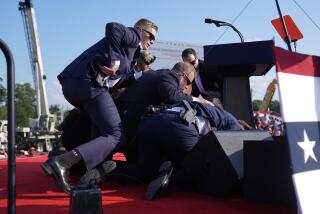Embassy Design Stresses Security : Terrorist-Proof Missions Are a Top State Department Goal
- Share via
Mounting concern over worldwide terrorism is sending architects and engineers back to their drafting tables to design building less vulnerable to attack.
Perhaps nowhere is the need for secure architecture more pressing than at U. S. embassies and other government missions overseas.
The U. S. State Department is in the midst of extensive efforts to upgrade security at foreign missions, fortified by a $366-million program passed by Congress last fall.
The State Department is also underwriting research into ways of making future buildings less assailable, setting standards for security enhancements and seeking fresh ideas on everything from new armor plating for cars to tougher window materials.
Although the research is just beginning, it is clear that tomorrow’s embassies will not resemble those of the past--open, airy, glass structures on easily accessible main roadways, symbols of America as a free society.
“I think we will never see the kinds of designs that were popular in the 1950s,” says Robert Lamb, the assistant Secretary of State in charge of day-to-day management of State Department buildings.
Designing structures that will limit intrusions is not just a modern challenge. It has been a concern since the days when the first villages were surrounded by moats and ramparts.
U .S. embassies, “islands” in a host country, pose unusual problems of their own. They are dependent to a large degree on the local government--friendly or not--for protection.
Buildings today also have to be designed to minimize risks that range from hostile mobs and sniper attacks to car-bomb terrorists. There may also be local considerations that limit what American officials can do to alter the design of existing buildings. Some offices are in historic buildings and can’t be modified at will.
Underlying any effort to improve security at foreign missions, though, is the need to ensure security without turning embassies into bunkers.
“The State Department’s job is to conduct the affairs of state, and you can’t do that by going into hiding,” says Stuart L. Knoop, president of Oudens & Knoop, a Washington architecture firm that specializes in designing U. S. missions.
Concern about buttressing buildings against terrorism is a recurring one, but they sharpened recently with the attacks on American posts in Beirut and Kuwait, as well as with the murders of American diplomats in Europe and Central America.
Recent terrorist hits on North Atlantic Treaty Organization targets and a videotaped message of U. S. Embassy officer William Buckley, one of five Americans kidnapped in Beirut in the past year, were painful reminders of the threat facing American interests abroad, too.
Between 1979 and 1984, the State Department increased expenditures on security worldwide roughly fivefold. This year the department is nearly doubling its allotment for security again, to $433 million, which includes some of the funding from last year’s supplemental $366 million package.
In the past four months alone, some 1,300 requests for security projects at missions around the world have piled up on the department’s desks. Many changes have already been made. Walls, bollards, guard booths and special doors have been put in at various posts. Some missions are virtual bunkers, protected by rocket shields and bomb deflectors.
But more is coming. Roughly half of last year’s special congressional package will go for 11 new outposts and two major renovations at unusually “high risk” sites, mostly in the Middle East. The new buildings will start going in next summer.
The National Academy of Sciences’ National Research Council, meanwhile, has set up a committee to look into ideas for enhancing security--everything from new building materials to electronic measures--and will suggest specific design criteria.
To be sure, bricks and mortar alone cannot a terrorist thwart. “There are no miracle solutions that will make these buildings totally safe,” says Paul Weidlinger, president of Weidlinger Associates, a New York City engineering firm that has prepared a report for the State Department on enhancing security.
But experts agree that better designs and other security precautions can repel certain types of intrusions and limit the damage others might cause.
Among the changes that Weidlinger and Knoop, both on the Research Council committee, see at future embassies:
--Fewer windows, particularly on lower levels. This doesn’t mean that buildings need be fortresses, says Knoop, who cites some museums and theaters as examples of attractive but secure structures. Where windows are put in, more will be shatter-resistant. Many injuries at last year’s embassy attack in Beirut were caused by flying glass. New high-strength window materials are being looked at.
--The embassy site will become more important. Fewer will likely be placed on heavily traveled thoroughfares, Knoop says. They will likely sit on larger parcels of land to help distance the buildings from outside areas. Within a building, most offices will be situated away from the street.
--Structures with underground parking garages or those built on stilts will probably be avoided. They make an attractive target for car bombs.
--To limit damage from bomb attacks, fewer flammable materials will be used in buildings.
--Landscaping--shrubs, trees, earth berms--can be used to help control vehicles and to screen windows from the view of snipers.
All this, of course, would be dovetailed with other precautions (guards, metal detectors, crash barriers) that are becoming routine parts of embassy compounds. “If it’s a trade-off between openness and human life, we are going to go with human life,” Lamb says.
More to Read
Sign up for Essential California
The most important California stories and recommendations in your inbox every morning.
You may occasionally receive promotional content from the Los Angeles Times.













